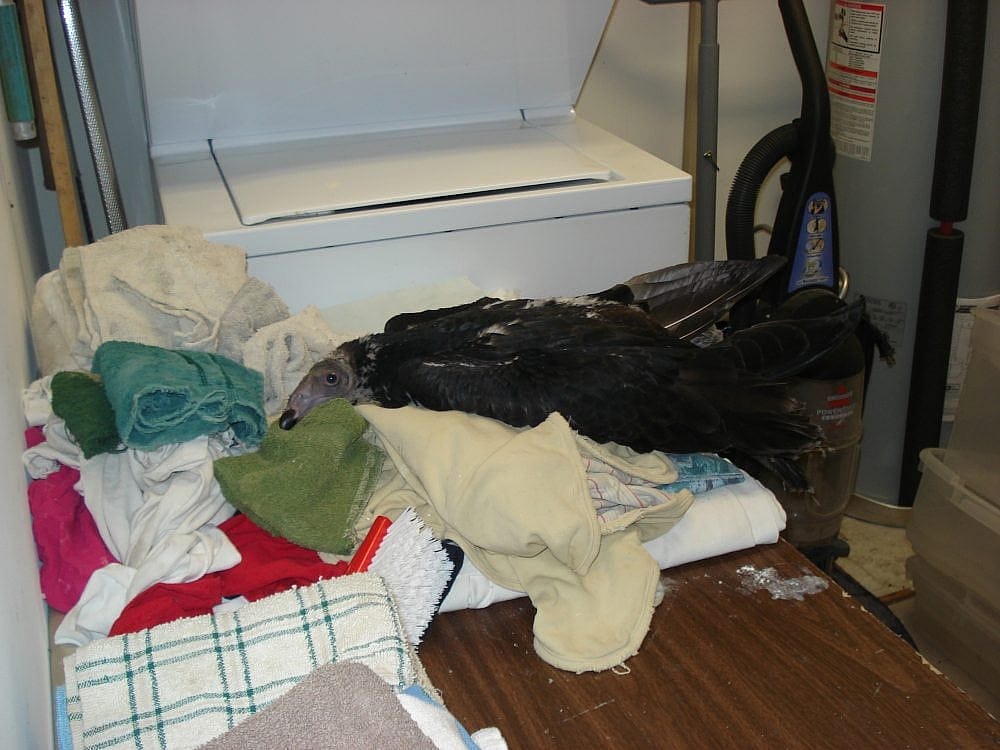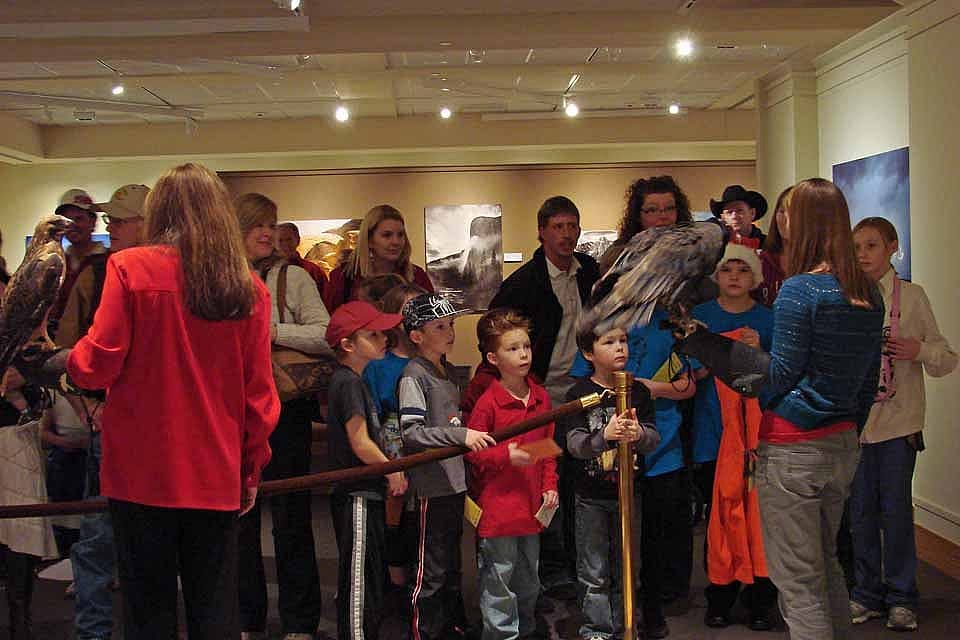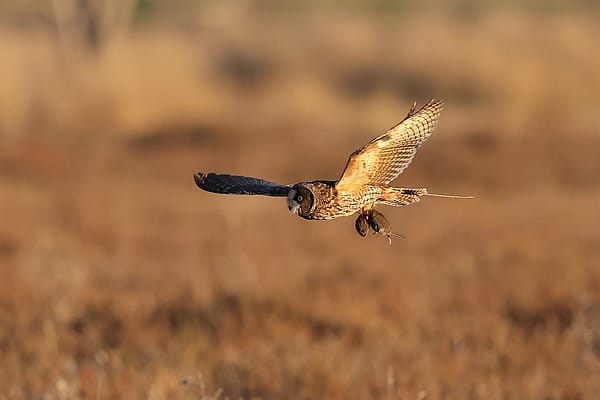
Ho Ho Ho, Merry Christmas!
Each year when December rolls around, the Buffalo Bill Center of the West helps the people of Cody and the nearby towns celebrate the Christmas season with an open house. This festive day includes Santa Claus, local entertainment, and for the last two years the birds of the Draper Museum Raptor Experience to wish our visitors a “Merry Christmas.” What a day! Just looking at the faces of the children, you can tell that our birds make an impression on them.
It is not only a big day for the public, but also for the birds, who were on display from 10 a.m. to 5 p.m. The volunteers who were able to help out took turns holding the birds and answering questions. Half past the hour all day long, starting at 10:30 a.m., Melissa gave talks about each of our birds. I don’t know how her voice held out! And she not only worked hard that day, but she did a lot of preparation for the open house, such as organizing, scheduling her volunteers, attending meetings, planning, and I am sure a lot more I don’t even know about.
I began my day by helping to set up in the John Bunker Sands Photography Gallery where the birds would be featured. I then carried Isham, our red-tailed hawk down, and waited for the visitors to begin arriving. At first Isham danced upon my glove, spinning and hopping, but after about 10 minutes he settled in and stood in a stately manner on each volunteer’s glove throughout the day. Isham is such a good boy, as well as handsome, and he tends to take everything without much fuss.
My second bird of the day was Suli, our turkey vulture. Suli wasn’t too sure about the whole thing, however not so upset that she was hissing or shaking. She did decide, however, that there was no reason to actually LOOK at the crowd. Turning her back on the audience, she settled in comfortably on the platform perch that I had placed her on. Standing with her leash locked into my fingers, I spoke softly to her. She reached over one time and gently lifted a piece of my hair. Occasionally looking over her back at the crowd of spectators, she would satisfy herself that there was nothing to worry about. Although she spent much of her time with her back to the audience while on her platform, when she stepped up onto one of our gloves, she didn’t turn away, but rather faced her adoring public (in her mind) watching them without showing any signs of fear. For a bird that gets easily bored, she did very well, patiently waiting through the hours for her time to return to her mew.
Hayabusa, our peregrine falcon, was her usual stunningly beautiful self, and was pleased to people watch as they watched her. The extra special treat for her was when Richard fed her on his glove. I am sure this was a treat for Richard also, as feeding her this way is such fun! Haya was thrilled! Yummy quail, her favorite! The public can thank Melissa for doing them a favor, as she had removed the skin from the quail before hand, so that Haya would not fling feathers all over the folks who were admiring her.
Teasdale, our great-horned owl, remained his serious self, occasionally slowly turning his head to check out the crowd, and other times just standing, looking at nothing in particular.
Everyone who visited the birds was interested and enchanted by them. One little girl told Melissa, “She (Hayabusa) is the baby, she (Isham) is the mom, and he (Suli) is the Daddy bird.” As I said, this was a small child, maybe three years old. She was tuned in to the sizes of the birds. Therefore our smallest bird, Hayabusa our peregrine falcon, had to be the baby. Isham, the red-tailed hawk, who is actually a male is a medium-sized bird in our group, so must be the mom. Suli, our turkey vulture, who is a female and our largest bird was therefore the dad.
I had a young man, maybe middle school age, who was fascinated by Hayabusa. He came up to me and shyly said, “I know they (peregrine falcons) have a special nose that makes it so that air can’t rush in and hurt their lungs.” Yes! I showed him her nostril, where he could see the beginning of the structure that causes the air to enter a falcon’s nostril in a circular manner, as they swiftly dive toward their prey. He then said, “I know they have another lens to close over their eyes like a windshield wiper.” Yes again, I explained to him that this nictitating membrane not only helps to clean the eyes, but also protects their eyes from dust particles when falcons are in a dive. I said to him, “You know a lot about peregrine falcons.” His response was, “I read one article about them.” I commented that he must have really enjoyed the article. He replied, “I really don’t read very much, but when I do, I remember the interesting stuff pretty good. I read this because it looked interesting.”
Melissa’s half-hour talks covered a variety of information. I will only mention a few of the things that she talked about. Melissa discussed how Isham, our red-tailed hawk, could eat four or five mice a day in the wild, therefore helping us with pest control. She also told the audience that red-tail hawks ate other mammals including those the size of cottontail rabbits, and birds up to the size of pheasants, as well as reptiles such as snakes, including rattlesnakes. When asked if he was allowed to fly around, she told the listeners that with one eye, he chooses not to fly, as landing is scary for him.
Melissa used her newest joke that always gets a laugh from the audience, explaining that Suli, our human imprint, grew up watching and learning from people, so she didn’t learn how to socialize with other vultures, or how to find her own food. She watched people doing laundry, typing, preparing meals, etc., so that she was more suited to be an office assistant than a vulture. She also explained how in the morning they open their wings and stand sunning themselves to warm up, then will float on the thermals for up to six hours, using very little energy.

Melissa explained how peregrine falcons are found all over the world, except for Antarctica. She told the visitors that birds are a peregrine’s favorite food, and they will hunt game birds, water fowl, song birds, and birds as large as blue herons, killing them by punching them with their feet after speedy dives as fast as 240 mph. When asked if Haya could fly, she explained that because of Hayabusa’s wing injury (we have recently discovered it is a severely damaged ligament, not a broken bone as we had earlier been told) she can only “fly” about three to four feet, and that is mostly because of the strong push off with her legs. She was also asked about a peregrine’s life expectancy. Ninety percent of peregrines do not survive their first year. Peregrines live a high-risk lifestyle and therefore often do not live long in the wild.
Talking about Teasdale, our great horned owl, Melissa explained how great horned owls can squeeze with their talons, using up to 500 pounds per square inch of pressure. She also pointed out that they eat similar food as red-tailed hawks do, but they can take items that are somewhat larger, such as skunks, a favorite food. Great horns will also eat birds (including other owls), mammals, and reptiles, as well as small cats and dogs. So, do watch your small pets if there is an owl in your area and remember that owls are so well camouflaged that there could be an owl living nearby, and you may never see it. And yes, they will live in residential areas.
As a special treat to our visitors, we also handed out free bookmarks. We have a design for each of our birds, and the visitors were asked to choose only one. I am sure that for some visitors this was a hard choice. Using the bookmarks, folks can check the birds out on Facebook. Liking the program on Facebook, as well as each bird individually, helps us to show that this is a popular program. So, if you are a Facebook member, and haven’t yet liked the birds, visit your page and search for Hayabusa the peregrine falcon, who has the least likes at this time, and her page can link you to the pages for each of our other birds.
Many children and adults, when seeing and hearing about our birds, are really fascinated by them. I always hope that for some of these folks our program will spark a life long interest that will carry beyond the BBHC doors. Will they look toward the skies? If they do, maybe they will spot these hunters on the wing.
Question from visitors:
When the birds are in their “cages” do they talk to each other?
First of all, their homes (mews) are more like rooms with solid walls that block each bird’s view of the other birds. Each mew has a large window with PVC bars (glass is potentially dangerous) to allow in natural air and sunshine. These birds have no relationship with each other. They are not friends in the wild or in captivity. In the wild the great horned owl, Teasdale, could eat any of our other birds.
Isham, our red-tailed hawk, is the only bird that we hear “talking.” He sometimes carries on a quiet solo of little sounds while standing in front of his window. Teasdale only makes sounds at us, hisses and occasionally beak clacks, to let us know that he is displeased. The peregrine may occasionally squawk at us, if she bates on pick-up. Suli, our turkey vulture has no voice box and can only hiss or grunt. She tends to hiss at things that are worrying her, such as items with wheels, or items in strange locations we may travel to. None of these vocalizations are aimed at each other.
Written By
Anne Hay
Anne Hay has a Bachelor's degree in Elementary Education and a Master's in Computers in Education. She spent most of her working years teaching third grade at Livingston School in Cody, Wyoming. After retiring she began doing a variety of volunteer work for the Buffalo Bill Center of the West’s Draper Natural History Museum. Anne loves nature and has a concern for the environment. She believes that educating the public, so that they will have a better understanding and appreciation for the natural world, is very important. Because of this belief, volunteering at the Center is a perfect fit. She spends time in the Draper Lab, observing eagle nests for Dr. Charles Preston’s long-term research project on nesting golden eagles, writing observation reports of raptor sightings in the Bighorn Basin, and working with the Draper Museum Raptor Experience. Anne states that, “Having a bird on my glove, is one of my all time favorite things in life.”




















